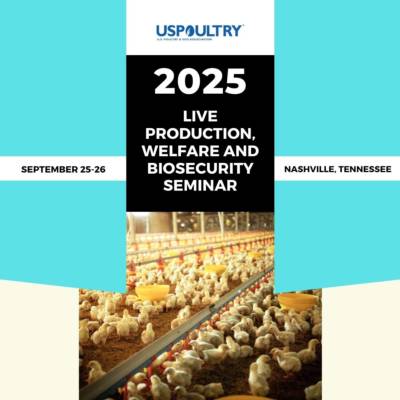- FOUNDATION
- |
- IPPE
- |
- PPFC
- |
- CONTACT
News Release
- Media Center Home /
- News Release View


For Immediate Release
U.S. Poultry & Egg Association
Tucker, Ga. - July 1, 2025
- Contact:
- Hannah Keck, 678.514.1979, hkeck@uspoultry.org, (USPOULTRY)
Researchers Evaluate Branched-Chain Amino Acid Interaction on Layer Production and Performance
USPOULTRY and the USPOULTRY Foundation announce the completion of a funded research project from Mississippi State University on layer hen production and performance. Due to limited resources on the interaction and requirements of lower amino acids in the layer industry, researchers aimed to investigate how branched-chain amino acid interactions affect the performance, feather quality and egg quality of laying hens. The research is part of the Association’s comprehensive research program encompassing all phases of poultry and egg production and processing and is made possible in part through proceeds from the International Poultry Expo, part of the International Production & Processing Expo.
Project #F-103: Understanding the Influence of Branched-Chain Amino Acid Interaction on Performance, Feather Quality and Egg Quality of Laying Hens
(Dr. Pratima Adhikari, Department of Poultry Science, Mississippi State University, Mississippi State, Miss.)
Feeding low crude protein diets is a well-established strategy to reduce feeding costs, minimize excess nitrogen and waste, and support profitability, animal health, welfare and sustainability in broilers and swine. Dr. Adhikari, associate professor at Mississippi State University, investigated how varying levels of leucine (Leu), valine (Val) and isoleucine (Ile), as well as their interactions, affect pullet performance and bone quality during the grower and developer phases, as well as layer performance and egg quality during the laying phase. This research is especially relevant for diets containing distillers dried grains with solubles (DDGS) and corn, as corn and its by-products are disproportionately high in Leu compared to Val and Ile. The researcher hypothesized that practical corn–soybean meal–DDGS diets with a high Leu:Lys ratio could create amino acid imbalances, negatively affecting performance, egg weight, feather quality, economic returns and the sustainability of egg production.
The research summary can be found on the USPOULTRY website. Information on other Association research may also be obtained by visiting the USPOULTRY website, uspoultry.org.
###
More Recent News
July 31, 2025
2025 USPOULTRY Live Production, Welfare and Biosecurity Seminar to Tackle Key Challenges in Live Production
The 2025 USPOULTRY Live Production, Welfare and Biosecurity Seminar will equip poultry professionals with practical tools and insights to address production efficiencies, welfare and bios...

July 28, 2025
Insights, Innovation and Compliance: What to Expect at USPOULTRY’s 2025 Environmental Management Seminar
Environmental managers in the poultry and egg industry face increasing pressure to meet regulatory demands while advancing sustainability and operational efficiency. USPOULTRY’s 2025 Envir...

July 22, 2025
Dr. Petek Settar Receives PSA Distinguished Poultry Industry Career Award, Sponsored by USPOULTRY
Petek Settar, Ph.D., managing director of research and development at Hy-Line International, was honored with the 2026 Poultry Science Association (PSA) Distinguished Poultry Industry Career Award,...
![]()
General Info
Events & Meetings
People & Groups
- Affiliated States
- Air Cargo Committee
- Hen Council
- Industry Partners
- Poultry Protein & Fat Council
- USPOULTRY Foundation
